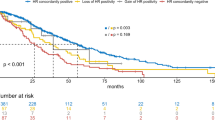Abstract
Background
Discordance rates of hormone receptor (HR) and human epidermal growth factor-2 (HER2) status between primary and recurrent breast cancer were reported to be in the wide range of 10–40 %, although its prognostic relevance remains to be elucidated.
Methods
Fifty-five breast cancer patients had biopsies or resections of recurrent lesions. Pathological assessments of the HR and HER2 status of primary and recurrent lesions were performed in a single laboratory at Keio University Hospital. Tumors were classified as luminal (HR+ and HER2−), luminal/HER2 (HR+ and HER2+), HER2 (HR− and HER2+), or triple negative (HR− and HER2−).
Results
Discordance rates in estrogen receptor (ER), progesterone receptor (PgR) and HER2 status between primary tumors and recurrent lesions were 16.4, 30.9 and 10.2 %, respectively. Overall, 14 patients (25.5 %) changed subtypes at recurrent lesions. Patients with a gain in ER and PgR status had a significantly longer disease-free interval compared with the corresponding concordant-negative patients (ER: 99.0 vs. 18.5 months, p = 0.037, PgR: 141.0 vs. 24.4 months, p = 0.011). Patients with a loss of HER2 status experienced a trend toward shorter time to progression, compared with patients who maintained HER2 positivity (4.0 vs. 18.4 months, p = 0.051).
Conclusions
Discordance in receptor status between primary and recurrent breast cancers were seen in 10–30 %. A gain in HR status was significantly associated with better prognosis.



Similar content being viewed by others
References
Siegel R, Naishadham D, Jemal A (2012) Cancer statistics, 2012. CA Cancer J Clin 62:10–29
Perez EA, Romond EH, Suman VJ et al (2011) Four-year follow-up of trastuzumab plus adjuvant chemotherapy for operable human epidermal growth factor receptor 2-positive breast cancer: joint analysis of data from NCCTG N9831 and NSABP B-31. J Clin Oncol 29:3366–3373
Early Breast Cancer Trialists’ Collaborative Group (EBCTCG). (2005) Effects of chemotherapy and hormonal therapy for early breast cancer on recurrence and 15-year survival: an overview of the randomised trials. Lancet 365:1687–1717
Amir E, Clemons M, Purdie CA et al (2012) Tissue confirmation of disease recurrence in breast cancer patients: pooled analysis of multi-centre, multi-disciplinary prospective studies. Cancer Treat Rev 38:708–714
Turner NH, Di Leo A (2013) HER2 discordance between primary and metastatic breast cancer: assessing the clinical impact. Cancer Treat Rev 39:947–957
Dieci MV, Barbieri E, Piacentini F et al (2013) Discordance in receptor status between primary and recurrent breast cancer has a prognostic impact: a single-institution analysis. Ann Oncol 24:101–108
Amir E, Miller N, Geddie W et al (2012) Prospective study evaluating the impact of tissue confirmation of metastatic disease in patients with breast cancer. J Clin Oncol 30:587–592
Thompson AM, Jordan LB, Quinlan P et al (2010) Prospective comparison of switches in biomarker status between primary and recurrent breast cancer: the Breast Recurrence in Tissues Study (BRITS). Breast Cancer Res 12:R92
NCCN Clinical Practice Guidelines in Oncology, Breast Cancer Version 3.2014. Available at http://www.nccn.org/professionals/physician_gls/pdf/breast.pdf
Liedtke C, Broglio K, Moulder S et al (2009) Prognostic impact of discordance between triple-receptor measurements in primary and recurrent breast cancer. Ann Oncol 20:1953–1958
Feng Y, Sun B, Li X et al (2007) Differentially expressed genes between primary cancer and paired lymph node metastases predict clinical outcome of node-positive breast cancer patients. Breast Cancer Res Treat 103:319–329
Aitken SJ, Thomas JS, Langdon SP et al (2010) Quantitative analysis of changes in ER, PR and HER2 expression in primary breast cancer and paired nodal metastases. Ann Oncol 21:1254–1261
Pusztai L, Viale G, Kelly CM et al (2010) Estrogen and HER-2 receptor discordance between primary breast cancer and metastasis. Oncologist 15:1164–1168
Bertos NR, Park M (2011) Breast cancer––one term, many entities? J Clin Invest 121:3789–3796
Wu JM, Fackler MJ, Halushka MK et al (2008) Heterogeneity of breast cancer metastases: comparison of therapeutic target expression and promoter methylation between primary tumors and their multifocal metastases. Clin Cancer Res 14:1938–1946
Mittendorf EA, Wu Y, Scaltriti M et al (2009) Loss of HER2 amplification following trastuzumab-based neoadjuvant systemic therapy and survival outcomes. Clin Cancer Res 15:7381–7388
Pectasides D, Gaglia A, Arapantoni-Dadioti P et al (2006) HER-2/neu status of primary breast cancer and corresponding metastatic sites in patients with advanced breast cancer treated with trastuzumab-based therapy. Anticancer Res 26:647–653
Wilking U, Karlsson E, Skoog L et al (2011) HER2 status in a population-derived breast cancer cohort: discordances during tumor progression. Breast Cancer Res Treat 125:553–561
Lower EE, Glass E, Blau R et al (2009) HER-2/neu expression in primary and metastatic breast cancer. Breast Cancer Res Treat 113:301–306
Falck AK, Ferno M, Bendahl PO et al (2010) Does analysis of biomarkers in tumor cells in lymph node metastases give additional prognostic information in primary breast cancer? World J Surg 34:1434–1441
Botteri E, Disalvatore D, Curigliano G et al (2012) Biopsy of liver metastasis for women with breast cancer: impact on survival. Breast 21:284–288
Acknowledgments
This study was supported by a Grant-in-Aid from the Ministry of Education, Culture, Sports, Science and Technology, Japan.
Conflict of interest
The authors declare that they have no conflict of interest.
Author information
Authors and Affiliations
Corresponding author
About this article
Cite this article
Matsumoto, A., Jinno, H., Murata, T. et al. Prognostic implications of receptor discordance between primary and recurrent breast cancer. Int J Clin Oncol 20, 701–708 (2015). https://doi.org/10.1007/s10147-014-0759-2
Received:
Accepted:
Published:
Issue Date:
DOI: https://doi.org/10.1007/s10147-014-0759-2




